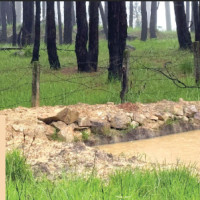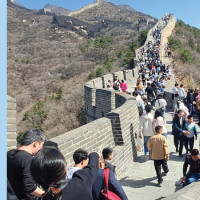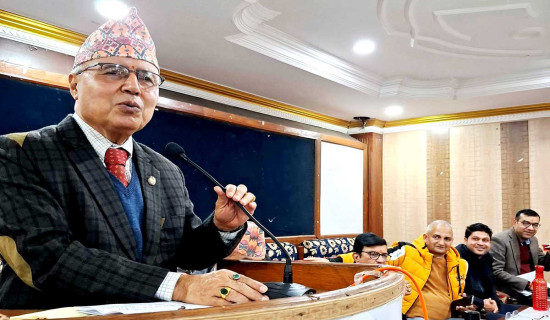- Monday, 8 December 2025
Travel Tales From Across The World
Recently I came across an article by John Washington in New York Review of Books where he describes the plight and pain of people smuggling themselves to cross the border to reach US. John himself was trying to sneak across the border between Guatemala and Mexico, researching for his book. The fragility of illegal immigrant trying to cross the border was heart rending, and it compelled us to think twice not only about the immigration laws but also about the very basic questions of human survival.
The impact of that painful story is elongated with another such story, with much elaboration, in a recently published travel writing "Sansarko Serofero" by Dr. Chandra Giri. The book is a collection of travel writing, which tells the tale of traveling around the world. Among the thirty-six essays, there is an article on Darien Gap. The writer was too anxious to know the harsh reality of the "hell way to heaven" and tried to explore the illegal route that ultimately leads to the US.
The dense tropical jungle that links Colombia and Panama spans more than 60 miles of swamp, dense rainforest, fast-flowing rivers and mountains. The food, water and all necessary items should be carried by the travelers and there is a danger that it would be looted by armed groups or drug smugglers. It is regarded as one of the most dangerous travel routes in the entire world, as people are exposed to insect bites, infections, diarrhea, dehydration, fractures, or skin injuries without any help even of basic first aid support. Still numerous people risk travelling along this route and many die on the way. Between 2018 and 2023, 258 people died in the Darien.
The writer finds out that the route only used by South Americans in the past is now being used by people from China, India, Bangladesh, Afghanistan, Cameroon, Angola, etc. And, of course there are people from Nepal too. He found a group of ten people from Rukum and talked with them. Little did they know what danger lay ahead for them.
"Sansarko Serofero" as the name suggests takes readers to the places around the globe. As an expert of Mangrove forest, writer Dr. Giri had the opportunities to travel 136 countries. Mostly, he visited for work, and sometimes for vacation. The book tells the traveling tales of Asia, North America, South America, Europe, Scandinavian countries and Oceania and of course about Nepal.
As a conservation scientist, Giri's writing is full of biodiversity and natural world. He has described the Lesser and Greater Flamingos of Lake Nakuru National Park. The countless flamingoes are often seen feeding side by side along the shores of Lake Nakuru, which creates the stunning pink hues across the landscape. Lesser Flamingos have historically been present in larger numbers at Lake Nakuru, sometimes in millions. People are amazed to see millions of those birds. So does the writer. We readers are delighted to read the experience of being amazed.
The writer has described the Monarch Butterfly in his trip to Mexico. Those butterflies fly for four thousand kilometres from Chicago to the hills of Mexico. Their journey is a wonder in itself. How do they reach the place they have never been before is a surprising factor. The sensory system of Monarch Butterfly allows them to pick environmental information, and they use sun compass to navigate the world. But these days Monarch's numbers are declining because of habitat loss and also by heavy chemicals used in controlling insects and weeds in agricultural land.
In another write up, readers may wonder reading the description of the rice planting land in Thailand, which is a UNESCO heritage site. Reading that article, readers will ponder if the rice plot would be a world heritage site Nepal has plenty of such sites, but unplanned and haphazard development hasn't upgraded either the city or the village. In the other essay, the description of Senegalese people worshiping Bebao tree reminds us our nature worshiping tradition.
The book has a variety of topics. Besides writing on natural assets and wonders, the writer has described cities and towns he had explored. He has described the major cultural heritage cites around the globe. Readers would be delighted to read about the Mayan Civilization and Angkor Wat.
When the author visits a city and writes about it, he does not just talk about the physical city. He also talks about the intangible culture that makes the city lively. He tastes the local food and drink. He enjoys the folk music and dance. The readers wander from Bali to Berlin. They learn about various aspects of Banaras. There is a description about the trip to Jamaica, and a tale about Bob Marley and also about Pele and Brazil. There is interesting and exciting narration on Lake Victoria and the Panama Canal. One would learn not only about the underwater world of the Maldives, but also about the joy of eating while watching aquatic animals swimming above from an underwater restaurant.
One of the many reasons this book touches the Nepali readers is that an ordinary Nepali, a person born in the Nepali hills, who has experienced the suffering of the hills and the hardships of the Tarai, has travelled around the world with Nepali sentiment. The book takes us on a world tour with vernacular language and spirit. "Sansarko Serofero" is a light reading that will soothe you and refresh you.
(Founder of Orchid Books, Godar is a freelance writer.)

















